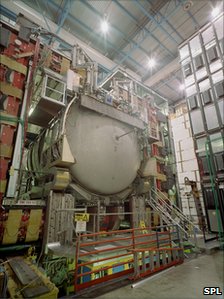
Physics suggests equal amounts of matter and antimatter should have been made in the Big Bang.
In 2010, researchers at the Tevatron accelerator claimed preliminary results showing a small excess of matter over antimatter as particles decayed.
The team has submitted a paper showing those results are on a firmer footing.
Each of the fundamental particles known has an antimatter cousin, with identical properties but opposite electric charge.
When a particle encounters its antiparticle, they “annihilate” each other, disappearing in a high-energy flash of light.
The question remains: why did this not occur in the early Universe with the equal amounts of matter and antimatter, resulting in a Universe devoid of both?
New physics?
The Tevatron results come from a shower of particles produced at the facility when smashing protons into their antimatter counterparts, antiprotons.
The proton-antiproton collisions in turn create a number of different particles, and the team operating the Tevatron’s DZero detector first noticed a discrepancy in the decay of particles called B mesons.
These decayed into pairs of particles called muons alongside pairs of their antimatter versions, antimuons. But, as the team reported in May 2010 in a paper published in Physical Review Letters, there was a notable 1% excess of the matter particles.
However, unpicking important events in the soup of interactions created in particle physics experiments meant that those measurements were associated with a level of uncertainty – reflecting the probability that the effect they see is a random statistical occurrence, rather than new physics.